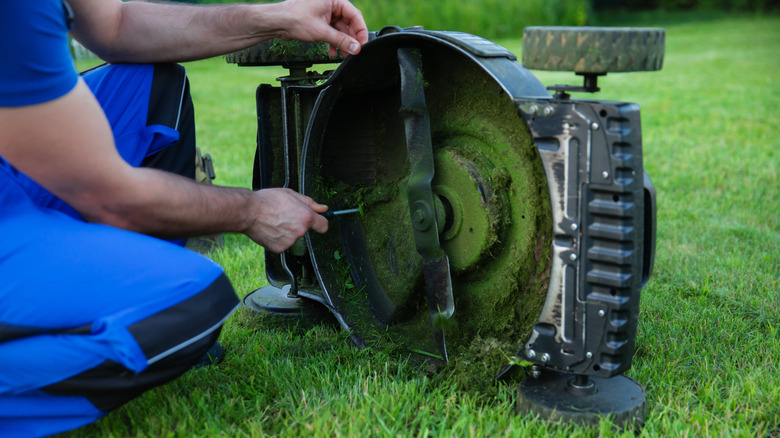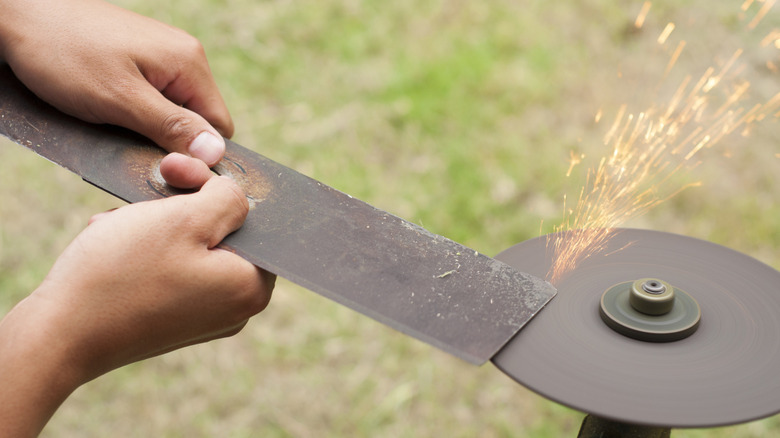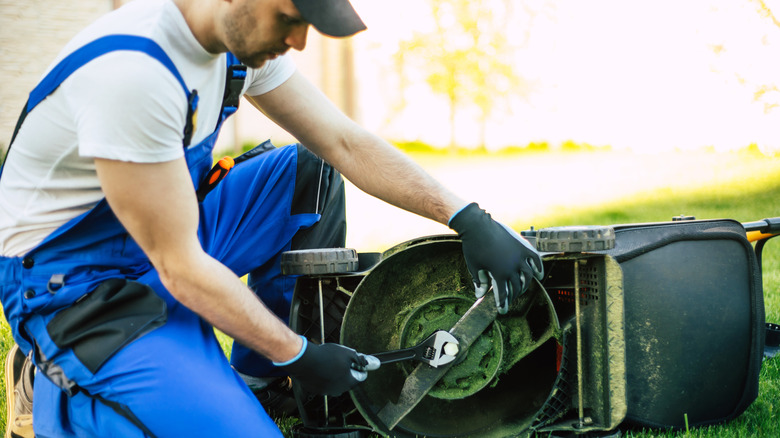Mistakes Everyone Makes When Sharpening Lawn Mower Blades
It's easy to get sold on the ergonomic handles, wider cutting decks, cushy seats, and hydrostatic transmissions found on the latest and greatest lawn mower models out there. But your blades are the most important component when it comes to keeping your lawn healthy and attractive. Lawn mower blades spin rapidly to lift and cut each blade of grass before mulching the clippings. Clean cuts help grass heal quickly from the trim and reduce the risk of disease. On the other hand, dull blades shred the grass, leaving jagged edges that look tattered and dry out unevenly, leading to brown spots. It's extremely important to keep your blades sharp, but according to Bryan Clayton, CEO of GreenPal, many homeowners skip this step to the serious detriment of their landscaping. Even those who do sharpen lawn mower blades frequently make mistakes like using the wrong angle, grinding the blade too thin, and skipping important safety steps.
"I've sharpened thousands of mower blades over the years, and most homeowners don't realize how much of a difference a clean, sharp edge makes," Clayton told House Digest during an exclusive interview. You'll know it's time to sharpen your lawn mower blades when your blades are uneven or bent, or your grass starts to look scraggly. The sharpening process can be tricky and isn't necessarily intuitive. "Here's the truth: Sharpening your lawn mower blade is something most homeowners screw up," the lawn care expert said. He explained that it's easy to get carried away, forget to balance the blade, or use cheap tools that don't get the job done.
Avoid over-sharpening at the wrong angle and using dull tools
Although there are a lot of tools that make it easy to safely sharpen lawn mower blades, there are several mistakes you should avoid to ensure you don't ruin them completely. During his exclusive interview with House Digest, Bryan Clayton said there's more to the process than guess work and grinding away. "You need the proper angle — not too steep or shallow — or the blade won't cut cleanly," he explained. Sharpening the blade too thin is another mistake to avoid. "Some folks get carried away and make it razor-sharp. Sounds great — until that edge chips off the second you hit a stick or a rock."
Along with over-sharpening, which makes the edge of your blade too fragile, Clayton said many homeowners forget to balance the blade after sharpening it. "If one side is heavier than the other, the blade wobbles and causes vibration. That wrecks the bearings and will destroy your mower deck over time," he cautioned. To confirm even weight distribution after sharpening, Clayton added that you'll need a blade balancer "or at least a nail in the wall to check both sides hang evenly."
Finally, the lawn care expert said you need to approach sharpening your mower blades with quality and safety in mind. Whatever you do, avoid using dull or cheap tools. "Trying to sharpen with a cheap file or a dull grinder won't get you the edge you need," he explained. And don't forget to wear your personal protective equipment. "No gloves, no eye protection, [blades] still mounted to the mower — bad idea. Always take the blade off first and secure it before sharpening," Clayton advised.
Sharpening lawn mower blades is a task best left to professionals
With all the potential for mistakes or injuries, does it even make sense to sharpen your lawn mower blades yourself? According to Clayton, you're probably better off leaving it to a professional. "Unless you've got a good grinder, a steady hand, and time, just take it to your local mower shop," he suggested during his exclusive interview with House Digest. Even if you're on a tight budget, you might be surprised at what it costs to have mower blades sharpened professionally. "They'll do it better, faster, and usually for around five bucks a blade," Clayton said, adding that you can take the blades off the lawn mower yourself to save a little money.
Nevertheless, you may still want to attempt sharpening your lawn mower blades yourself. If you do, the lawn care expert offered some advice you should keep in mind. "If you're dead set on doing it yourself, use an angle grinder with a flap disc," he advised. "Keep the factory angle and always check the balance when you're done." Clayton said that you should only need to complete the process a few times a year, making it a lot more sensible to forego the hassle entirely by leaving it to a pro.


